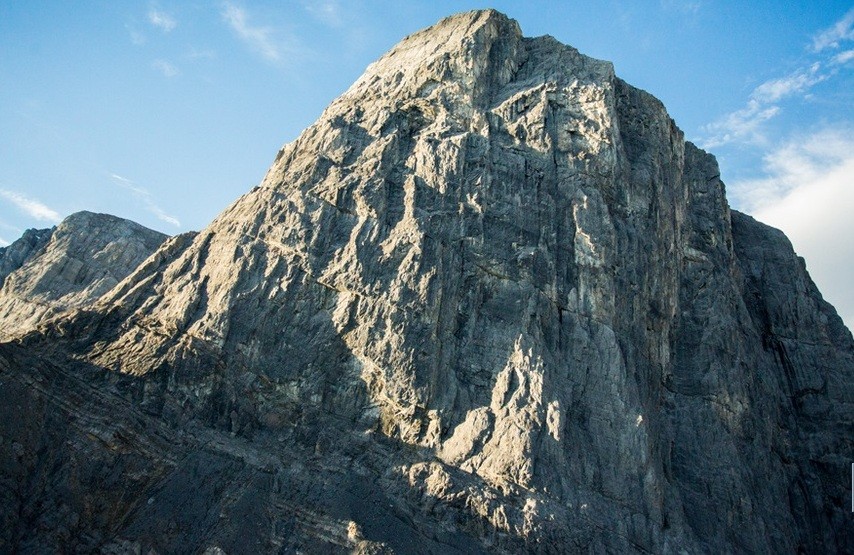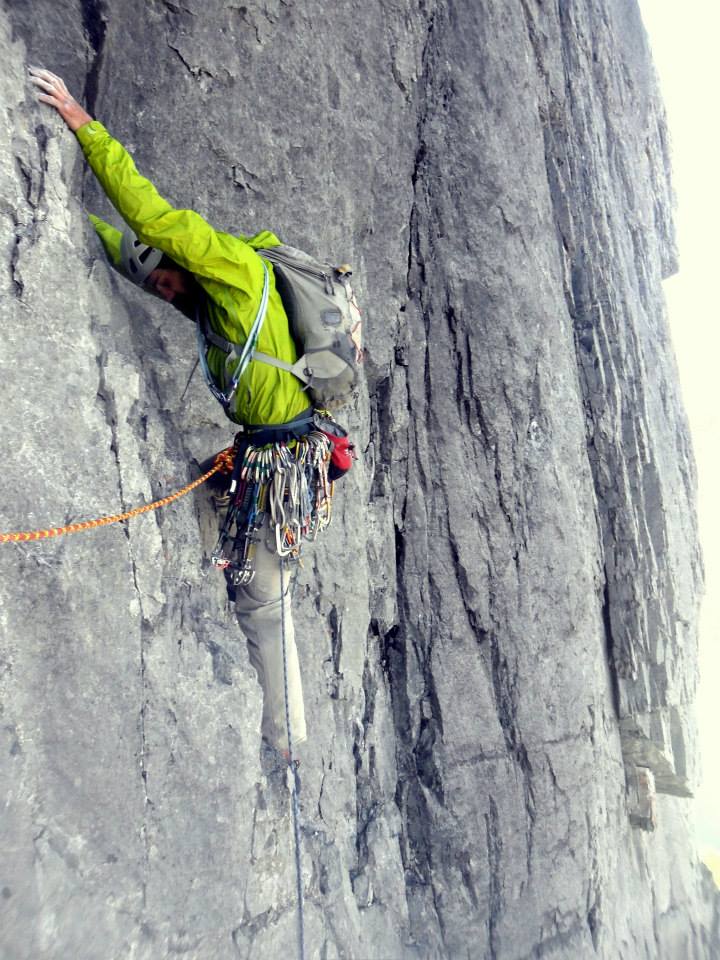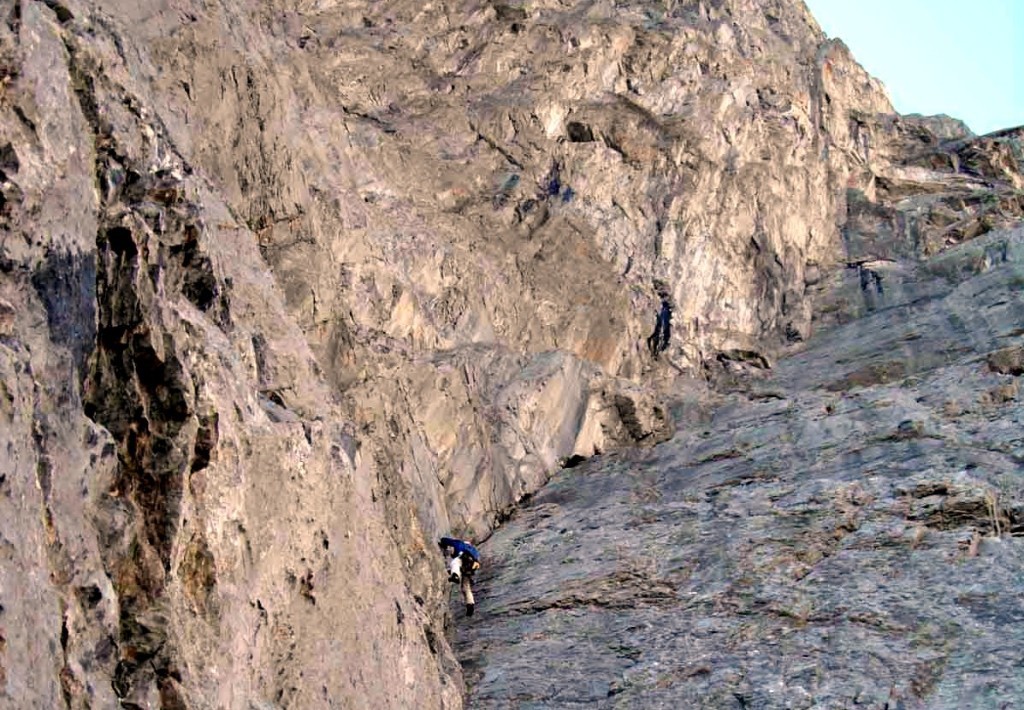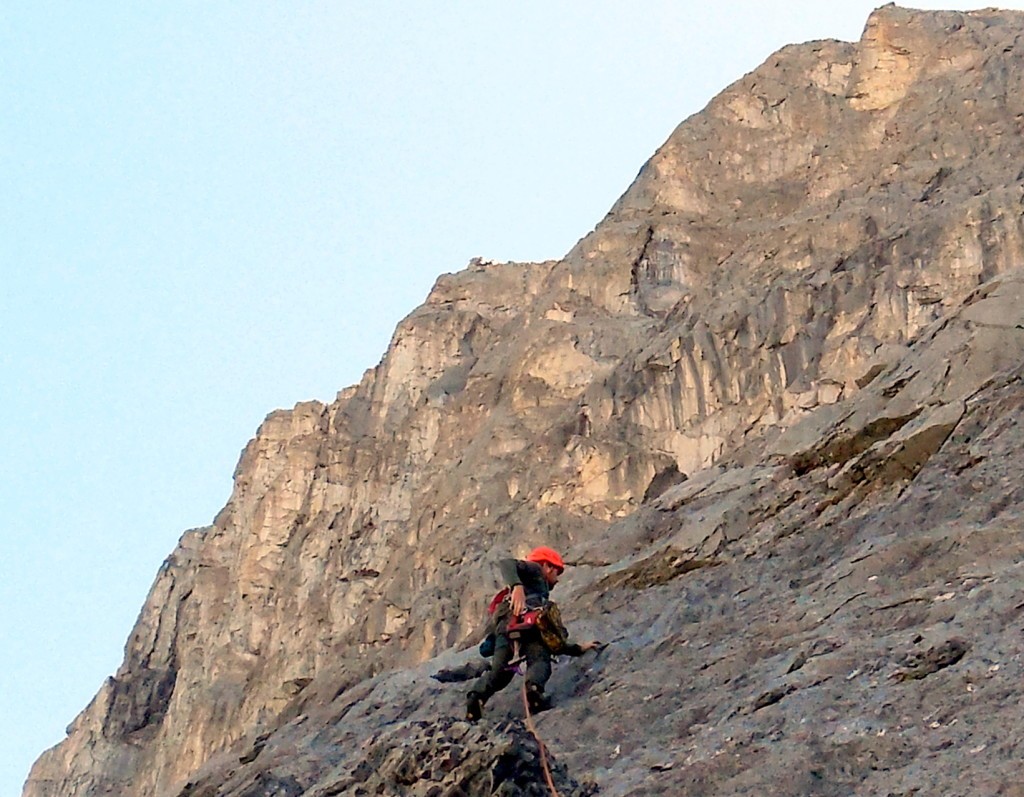Portrait of a Mountain: Ha Ling Peak

Ha Ling is a Canadian Rockies landmark found above the town of Canmore. The peak is a popular hike and has some of the most sought-after multi-pitch routes in the Bow Valley.
It was in October 1886 that a 28-year-old Chinese cook named Ha Ling was bet 50 dollars he couldn’t climb an unnamed, but sometimes referred to as the Beehive, 2,680-metre peak near Canmore. He had to climb the peak and make it back to town in 10 hours. His victory was met with doubters and the following day he took a group of people to the top and placed a larger flag next to the one from the previous day.
A newspaper in Medicine Hat wanted to name the peak Ha Ling, but the anti-Chinese sentiment at the time created a 100-year naming controversy. In the 19th Century, the mountain’s name was Chinaman’s Peak.
In 1965, the Historical Society of Alberta reprinted the 1896 story. Banff historian, Jon Whyte, wrote an article in the local newspaper suggesting the name be changed to Ha Ling, but he was ignored.
In 1980, the Canadian Permanent Committee on Geographic Names and the Alberta Historic Sites Board ratified Chinaman’s Peak as the official name of the mountain. People objected, saying the name was offensive. Some 1,522 Canmore residents signed a petition to keep the name Chinaman’s peak.
It wasn’t until in 1997 that members of the Chinese communities in Canmore and Calgary formed a committee to rename Chinaman’s Peak. The Committee’s appeals followed the Government of British Columbia’s decision to remove four names with “Chinaman” in the titles.
Finally, in July 1998, the name was officially changed to the century-old suggestion and called Ha Ling Peak.
By the time the name was changed, there were a half-dozen traditional routes on its north face. Over the last two decades, a few modern routes have been established, but potential for long and difficult new routes remains.
A-Northeast Face 5.7 / B-Sisyphus Summits 5.10d, B1-Optional traditional finish 5.10/ C-Orient Express 5.11c, C1-Orient Express (variation) 5.10, C2-Orient Express (original finsih) 5.8, C3-Orient Express (direct finsih) 5.10d / D-Remembrance Wall 5.11a / E-A Particular Manner of Expression 5.12a / F-Premature Ejaculation 5.10b / G-Quick Release 5.10a, G1-Quick Release Finish 5.10a, G2-Finishing Touch 5.10a / H-Soft Moth 5.9
Climbing History
The climbing on Ha Ling ranges from good to downright poor. Some rock is solid and some is loose. The wall is divided into three bands, each about 200 metres high, but it varies. The lowest band is the worst and offers poorly protected climbing (for the most part), but gets better in the second band and even better in the upper third.
The Canadian Rockies are known for their run-out, loose routes, so few lines get an R or X grade. Just a heads up, most of the routes on Ha Ling have run outs that can last for over 10 metres or more and the protection can sometimes be dodgy. The more modern lines have protection bolts where you need them. The descent for all routes is down the hiker’s trail on the southern slopes.
A – The Northeast Face 5.7, 450 metres was first climbed in 1961 by Brian Greenwood and party. It’s the classic route of the peak and sees more ascents than all others combined. It starts up third-class slabs and climbs a series of corners and easy face moves to the upper dihedral. The final four pitches offer esthetic views down the route to Canmore below. All of the anchors are fixed to rappel, but it’s not recommended as the route still has tons of loose rocks. In saying that, it’s important to note that people have died from rockfall and from falling off the route so despite the moderate grade, it’s not to be taken lightly. In the late 90s, two climbers from Northern Ontario fell off the wall when pitons between them failed during a leader fall, they both died. Many of the pitches have protection bolts, but you still need a rack of gear. A number of variations have been climbed up this part of the mountain. Tread lightly and beware of other climbers above and below. Pulling onto the summit for your first time is a great feeling. The route has been soloed in less than an hour.

B- Sisyphus Summits 5.10d, 600 metres was, for a number of years, the longest sport route north of Mexico. The route was rap-bolted in 1994 by Roger Chayer, Hugh Lenny and G. Hill to the dismay of many. Broken into 25-metre pitches, the line aims for the best rock. It succeeds, but in places the line is contrived and bolts are hard to clip. It’s not the best route on the mountain, but a great way to get in a lot of mileage with minimal rack. Make sure you have good rubber as the climb is more/less a giant slab. The holds are small and smeary. Of all the pitches, only two 5.8 pitches are chossy, the rest is solid and it stays cool on hot days. The optional finish climbs a fun series of cracks but requires a rack of gear. Geoff Powter has soloed the route three times, keep that in mind when on the upper cruxes.
C- The original north face route, Orient Express 5.11c, 545 metres was first climbed by Jack Firth, Chris Perry and Mike Sawyer in 1976 at 5.9 A3. Before they made their ascent, they found two pitches fixed left of where they climbed. The fixed lines were from a Japanese team in the 1960s. The first ascent took three days and followed a direct line involving some sections of aid. The aid was avoided on the second ascent by climbing an essentially free line to the left by Urs Kallen and Dave Cheesmond in 1983. A few weeks later, Chris Perry and Dave Morgan freed the left-hand variation at 5.9. The line is now considered 5.10b/c as many holds have broken. Over the years, a few variations have been climbed on the Kallen/Cheesmond variation. The original line was freed by Raphael Slawinski and R. Deberyer in 1999 at 5.11c. They hand-drilled new bolts at most of the belays and added one through the A3 section, the route has only been freed a handful of times. It’s not a sport route by any means and still has a very old-school feel. In saying that, it has some of the best climbing on the wall. The fun begings right off the deck with some serious moves. Sometime during the last five years, the strong Swiss climber Peter Gatzsch added a difficult direct finish to Orient Express. With a number of protection bolts, the three pitches of 5.10d are said to climb some of the most solid stone on the north face.
D – The Remembrance Wall 5.11b/c, 555 metres is Ha Ling’s testpiece. With likely only a dozen or so ascents since it was first climbed in July 1987, if that, it remains one of the most serious routes in the Bow Valley. First climbed by Steve DeMaio and Jeff Marshall, the difficulty is a testament to the two climbers who pushed technical and dangerous climbing in the 1980s. Named in memory of Dave Cheesmond, Ian Bolt, D. Guthrie and D. Monroe, all of whom died in the mountains in 1987, the line climbs the most esthetic left-facing and steepest dihedral on the wall. The first few pitches are very loose and run-out, but they’re nothing compared to the middle three pitches. Leaving the security of the low-angle band of rock, you climb up steep corners with little protection and insecure movements. A few old rickety pitons mark the safest path, but it’s hardly safe. One experienced climber took such a big whipper, they bailed never to return. The final ascent came after a number of attempts and despite almost breaking through the upper-third of the wall through steep roofs, the first ascent team bailed left on a 5.9 traverse to Orient Express. No one has dared attempt to push the line up and if you do, remember that it should be done with the style and ethics of DeMaio and Marshall in mind. The first ascent aided their way up a number of moves and the first free ascent was by Raphael Slawinski and Eric Dumerac. The hardware needs to be upgraded as most of the anchors have at least one self-drive bolt from the 80s.

E – A Particular Manner of Expression 5.12a, 12 pitches was the brain child of Jeff Relph. He put in a number of days establishing this route ground up with a variety of partners over a couple of years. Not knowing Relph had been working on the wall, Nick Rochacewich and Brandon Pullan started 50 metres right of Relph’s start and once they found anchors, they abandoned the attempt. Once the route was finished, Relph used Rochacewich and Pullan’s original pitches of which Rochacewich onsight-bolted a hard 5.10c pitch. This is the hardest route on the mountain, but has better protection than Remembrance Wall. The 12 pitches become more difficult the higher you climb. It was redpointed by Jeff Relph with Mike Trehearne and Joshua Lavigne. It’s had a number of ascents and is said to be one of the best long 5.12 routes in the area. It requires an extensive rack, despite having many protection bolts.
F – Premature Ejaculation 5.10b, 400 metres is almost as dirty as it sounds and anyone who’s climbed it knows how memorable it can be. First climbed in 1985 by Dave Cheesmond and Brian Gross, the route takes a prominent dihedral straight up the right side of the north face. First attempted by Steve DeMaio and John Kaandorp who climbed a more direct line up the lower face, but had to make a dangerous traverse right onto the route Quick Release to escape the upper climbing, their line was dubbed Premature Evacuation, which inspired the naming of the finished route. In some recent guidebooks the seriousness of the route is underplayed, evident from the number of bail slings. Some say Premature Ejaculation is hard for the grade and other climbers say it’s the best route on the mountain, you be the judge.

G – Quick Release 5.10a/b, 375 metres was climbed by Trevor Jones and Jon Bauer in July 1976 and takes the farthest right-hand major dihedral feature on the north face. The route is often wet and has some serious climbing in the first few pitches. The protection is good throughout with fixed gear where you need it. Bring a hammer to be sure the pitons are solid as they’ve been there for a few decades. The first ascent team traversed right and finished up a nice right facing corner. In 1985, Brian Gross, Brian Baxter and Choc Quinn straightened out the route and put a direct finish on it called Finishing Touch. It added four more engaging pitches, as opposed to the easier right-hand finish. The climbing is steeper than it looks so be prepared to use all of your corner climbing tricks, it’s a tad on the bold side. The rock is very good on these routes, a result of the spring seepage. In 2014, climbers reported that a loose flake blocked their way. Another party, that climbed the route in 2013, said the flake was loose, but they made their way around it. Some say it’s on pitch-three and others say it’s on pitch-five, it depends on how you link the pitches. The flake on Quick Release vibrated with a light tap and is the size of a small fridge. The winter of 2014/15 had a number of freeze/thaw cycles, which could have loosened the block even more so maybe best to stay away for now.
H – In 1966, Billy Davidson and John Braun climbed slabs on the western flank of the peak. In search of the old route, Brandon Pullan and Nick Rochacewich went looking and in doing so established a route they called Slayer 5.8, 600 metres. Pullan later found photos of Davidson and Braun on their route and realized the line started even farther right and skirted the edge of where rock meets scree. They pitched out a number of fifth-class pitches and never documented their route because Davidson considered it too easy. Nevertheless, their ascent is noted here because it was the second technical route on the mountain and was given an F4 in Davidson’s journal, which translates to about 5.6 today. After Rochacewich and Pullan climbed Slayer, a few other parties repeated it and complained of the ease of climbing as the route takes advantage of three long ramps that, when viewed from far, form the letter S. Pullan returned in 2014 with Gaby James and straightened it out. The result is Soft Moth 5.9, 500 metres, which climbs the best rock on this part of the peak. The lower-third is easy fifth-class, but the upper pitches gradually get harder. The route is mostly bolted and you only need a single rack. An option to pitch-10 is one of the best 5.10b traditional cracks on Ha Ling.

Projects
Development on Ha Ling seems to go through spurts. There are bail anchors, rap anchors and tat everywhere there aren’t recorded lines. Three main challenges remain and they’re the line of roofs between Sisyphus Summits and Orient Express, the direct finish to Remembrance Wall and the large black wall between Quick Release and Soft Moth which is currently being projected at 5.13.
An online guide to a number of the routes, written by Chris Perry, can be found here.




